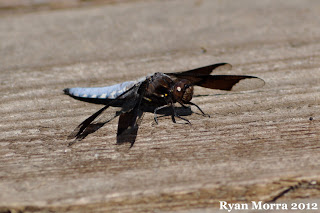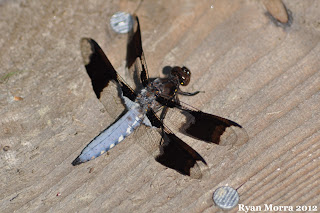What: I have been seeing this beautiful, big, white-bodied dragonfly with distinct striping on its wings for over a month now in Centennial Woods. I could tell immediately that this was a dragonfly and not a damselfly (the other major group of Odonates) because of its large abdomen and broad four translucent wings that lay flat when at rest (a damselfly’s wings would rise up vertically). I once worked with an ecological researcher who studies dragonfly behavior, but I couldn’t remember for the life of me what this particular one was. Was it a darner, a skimmer, a cruiser, an emerald (common groups of dragonflies)? So I scoured the internet trying to remember what this very common white-tailed dragonfly was, and lo and behold, it is the Common Whitetail (Plathemis lydia, formally Libellula lydia). It is so common, in fact, that it is found in all of the 48 conterminous United States and most of the Canadian provinces.
As for the butterfly, it didn’t take too long to identify it using this site: http://www.thebutterflysite.com/vermont-butterflies.shtml. I took a look at the names for the different butterflies, and noticed that there was a group called “Swallowtails.” If you look a the photo above, you’ll see that is a fitting name for this kind of butterfly. Then I looked through the names of Swallowtails, and noticed there were two species named “Tiger Swallowtail,” again, the yellow wing with black striping suggests such a name would be apt. One is the Canadian Tiger Swallowtail (Papilio canadensis), and the other is the Eastern Tiger Swallowtail (Papilio glaucus). I tried to read a little bit more on distinguishing the two, but the most common trait identified was the smaller wingspan of the Canadian, which is not of much help to meet with this one fleeting photo I captured. I am happy with my Papilio classification – you can add more if you’d like!
Ecological notes: Common to members of the Odonata, the Common Whitetail dragonfly starts off life as an aquatic “nymph.” You’ll remember seeing dragonfly and damselfly nymphs in collections of stream macroinvertebrates if you ever did those exercises in school! This particular dragonfly nymph is tolerant to polluted waters, so it is not used as an indicator of stream health (although it doesn’t mean the stream is unhealthy if they are present). Both the nymphs and the adults feed on other insects, so remember to not be afraid of these possibly intimidating insects, as they will help keep those mosquito and black fly populations in line!
Where: I encountered this breeding male (as denoted by the starch-white abdomen) basking on the boardwalks that run through the powerline cut in Centennial Woods, close to the stream. This is really where it thrives, as it is after mosquitos and other insects that are found around ponds and slow-moving streams. This male stayed very close to one piece of boardwalk, and that is also a common behvaior, as breeding males with guard a 10-30 meter stretch of river or pond side as their territory. I saw another male Whitetail about 100 feet up the trail on the other side of the stream, most likely guarding its territory.
Other notes: It was fun to finally explore more of our charismatic minifauna, as I think these two are both beautiful and showy, albeit small in size. These are two great insects to get to know, as they are apparently very common throughout North America. Now it’s time to explore more butterflies and dragonflies. Be on the lookout for the Vermont state butterfly – the Monarch – on its massive migration to feed on milkweed later in the summer!



